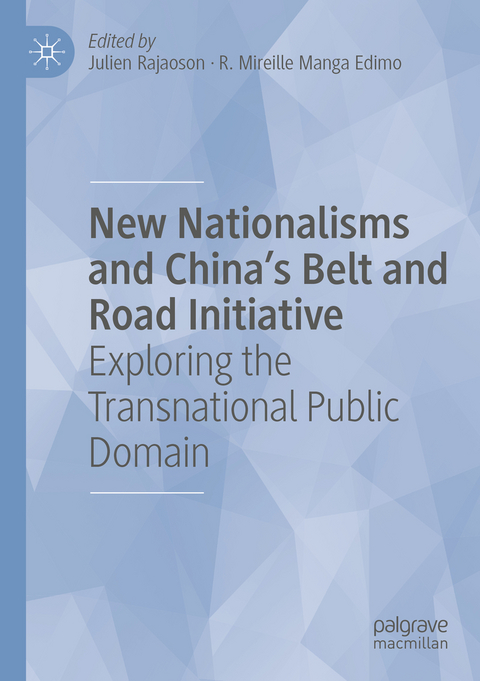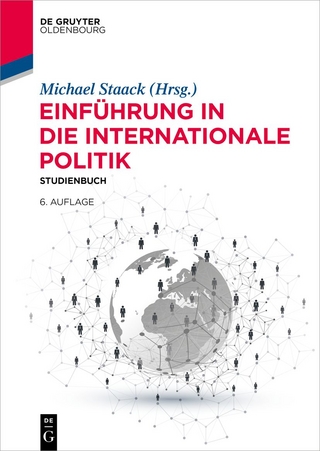
New Nationalisms and China's Belt and Road Initiative
Springer International Publishing (Verlag)
978-3-031-08528-4 (ISBN)
Readers of political theory, global political economy, globalization, international relations, political sociology, cultural sociology, public policy and foreign policy analysis will find interest in the book. Whereas new nationalism couples with globalism, both concepts are rediscovered through various socio-economic contexts of BRI policy discourses, which produce conflicts, solidarities, new economic partnerships, and cooperation and resistance as types of contemporary nationalism. The new nationalism is approached as a dual-sided, relational, and dialectical phenomenon which readers will capture by paying particular attention to both the global and local scales of the social responses to the BRI.
lt;p>Julien Rajaoson is a temporary teaching and research associate at the University of Nice Côte d'Azur, France.
R. Mireille Manga Edimo is a senior lecturer of public policy and international relations at the University of Yaoundé II, in Cameroon.
Chapter 1: Introduction.- Chapter 2: The BRI in a Multipolar World: A Normative Tool for Cooperation or Nationalism?.- Chapter 3: Margins of Autonomy in the Chinese Belt Road Initiative: Negotiating Growth in Rural Angola.- Chapter 4: China's Belt and Road Initiative in Three Diverse African Countries: A Comparative Approach.- Chapter 5: A Challenging nation-state in the Middle East in transition.- Chapter 6: "New Silk Roads" in the service of a "great power"? The influence of Xi Jinping's operational code in the strategic orientations of the People's Republic of China.- Chapter 7: China in Central Europe: The End of the Dream.- Chapter 8: In Rethinking The Belt and Road Initiative. An (Ir) replaceable Polish Factor.- Chapter 9: Consolidating Laoness - China in Laos in the age of the BRI.- Chapter 1 : India's response to the Belt and Road Initiative.- Chapter 11: Cyber-Nationalism in China: Popular Discourse on China's Belt Road.- Chapter 12: The Integration of Cities as The Nodes of Chinese Cultural Belt Road Worlds: The Case of Jingdezhen City.- Chapter 13: The Belt and Silk Road: Do these ties bind China and South Africa?.- Chapter 14: China's economic diplomacy in the context of the far-right government's neoliberal nationalism: the case of Brazil's energy sector.- Chapter 15: A Tale of Two Approaches: Australia, Papua New Guinea and the Belt and Road Initiative.- Chapter 16: China's Agro-strategic Projection in sub-Saharan Africa : the Case of the Installation of the Cameroon Agricultural Technology Application Center.- Chapter 17: From Landlocked to Land-linked: Kazakhstan as a transport and logistics Centre within the Silk Road Economic Belt.- Chapter 18: Engaging Israel in the Belt and Road Initiative: China's Techno-Nationalism in the Middle East.- Chapter 19: Development Cooperation through Maritime Silk Road: China's Big Ambitions and Mixed Responses from Southeast Asia.- Conclusion.
| Erscheinungsdatum | 30.10.2023 |
|---|---|
| Zusatzinfo | XXIII, 308 p. 11 illus. in color. |
| Verlagsort | Cham |
| Sprache | englisch |
| Maße | 148 x 210 mm |
| Gewicht | 435 g |
| Themenwelt | Sozialwissenschaften ► Politik / Verwaltung ► Europäische / Internationale Politik |
| Wirtschaft ► Volkswirtschaftslehre ► Wirtschaftspolitik | |
| Schlagworte | China's belt and road initiative • China’s belt and road initiative • China’s economic growth • China's Economic Growth • Chinese techno-nationalism • Geoeconomics • International Integration • Politics and economic nationalism • The belt and road initiative in Africa • the BRI • The New Silk Roads |
| ISBN-10 | 3-031-08528-0 / 3031085280 |
| ISBN-13 | 978-3-031-08528-4 / 9783031085284 |
| Zustand | Neuware |
| Informationen gemäß Produktsicherheitsverordnung (GPSR) | |
| Haben Sie eine Frage zum Produkt? |
aus dem Bereich


